The Temporal and Spatial Variations in Lake Surface Areas in Xinjiang, China
Abstract
:1. Introduction
2. Materials and Methods
2.1. Study Area
2.2. Data Collection
2.3. Extraction of Lake Surface Area from Landsat Image
2.4. Statistical Analysis
3. Results and Discussion
3.1. Spatial and Temporal Variability of Temperature and Precipitation
3.2. Variations in Lake Area and Landuse in Each Region
3.3. Relationships between the Lake Area and Climate Variables
4. Discussion
5. Conclusions
- (1)
- The annual variations in lake surface areas are different across six different regions. The surface area of Kanas Lake (Region I) did not show any obvious change during 1972~2015, due to its U-shape cross-sectional profile, which means that the water level is a better variable than lake area to study the relationship between lake variation and climate factors; lake area in Region II largely increased in the 1980s and then slightly decreased; lake area in Regions III and V increased and then decreased with the peaks in the early 2000s; lake area decreased in Region IV but increased in Region VI.
- (2)
- Lake areas also show different relationships with climate variables across six different regions. The surface area of Kanas Lake (Region I) did not show any obvious relationship with climate variables; lake area in the other regions of all lakes (except Sayram Lake in Region III) was positively correlated with annual precipitation (AP), and this was significant in Ebinur Lake in Regions III and IV; lake area in Regions II and IV was negatively correlated with annual mean temperature (AMT), and evapotranspiration had a great impact on lake area; lake area in Regions V and VI was positively correlated with annual mean temperature (AMT), and snowmelt and glacier melt had a great impact on lake area. However, in Region V, the effect of snowmelt was diminished by human activity.
Acknowledgments
Author Contributions
Conflicts of Interest
References
- An, C.B.; Feng, Z.D.; Barton, L. Dry or humid? Mid-Holocene humidity changes in arid and semi-arid China. Quat. Sci. Rev. 2006, 25, 351–361. [Google Scholar] [CrossRef]
- Wang, X.; Shiyin, L.; Wanqin, G.; Junli, X. Assessment and simulation of glacier lake outburst floods for Longbasaba and Pida lakes, China. Mt. Res. Dev. 2008, 28, 310–317. [Google Scholar]
- Fang, C.L.; Bao, C.; Huang, J.C. Management implications to water resources constraint force on socio-economic system in rapid urbanization: A case study of the Hexi Corridor, NW China. Water Resour. Manag. 2007, 21, 1613–1633. [Google Scholar] [CrossRef]
- Zhang, J.; Xu, J.; Zhang, Y.; Wang, M.; Cheng, Z. Water resources utilization and eco-environmental safety in Northwest China. J. Geogr. Sci. 2006, 16, 277–285. [Google Scholar] [CrossRef]
- Wu, J.; Ma, L. Lake evolution and climatic and hydrological changes in arid zone of Xinjiang. Mar. Geol. Quat. Geol. 2011, 31, 135–143. (In Chinese) [Google Scholar]
- Tang, G.; Zheng, W.; Wang, X.; Zhu, Y. Evaluation and development of folklore tourism resources in Kanas. Grassl. Turf 2017, 37, 98–103. (In Chinese) [Google Scholar]
- Toops, S. Tourism in Xinjiang, China. J. Cult. Geogr. 2009, 12, 19–34. [Google Scholar] [CrossRef]
- Wang, S.M.; Dou, H.S. Chinese Lake Catalogue; Science Press: Beijing, China, 1998. (In Chinese) [Google Scholar]
- Zheng, S.L.; Luo, L.P. Variation of water quality in Balikun lake in the last 18 years and water resource protection strategies. Environ. Sci. Technol. 2011, 34, 85–88. [Google Scholar]
- Ma, L.; Wu, J.; Abuduwaili, J.; Liu, W. Geochemical responses to anthropogenic and natural influences in Ebinur Lake sediments of arid Northwest China. PLoS ONE 2016, 11, e0155819. [Google Scholar] [CrossRef] [PubMed]
- Guo, M.; Wu, W.; Zhou, X.; Chen, Y.; Li, J. Investigation of the dramatic changes in lake level of the Bosten Lake in Northwestern China. Theor. Appl. Climatol. 2015, 119, 341–351. [Google Scholar] [CrossRef]
- Liu, H.; Yin, Y.; Piao, S.; Zhao, F.; Engels, M.; Ciais, P. Disappearing lakes in semiarid northern China: Drivers and environmental impact. Environ. Sci. Technol. 2013, 47, 12107–12114. [Google Scholar] [CrossRef] [PubMed]
- Zhang, Y.; Wei, W.; Jiang, F.; Liu, M.; Wang, W.; Bai, L.; Li, K. Brief communication “Assessment of change in temperature and precipitation over Xinjiang, China”. Nat. Hazards Earth Syst. Sci. Discuss. 2012, 2, 1289–1291. [Google Scholar] [CrossRef]
- Zhou, H.; Chen, Y.; Perry, L.; Li, W. Implications of climate change for water management of an arid inland lake in Northwest China. Lake Reserv. Manag. 2015, 31, 202–213. [Google Scholar] [CrossRef]
- Cheng, W.; Wang, N.; Zhao, S.; Fang, Y.; Zhao, M. Growth of the Sayram Lake and retreat of its water-supplying glaciers in the Tianshan Mountains from 1972 to 2011. J. Arid Land 2016, 8, 13–22. [Google Scholar] [CrossRef]
- Bao, A.; Mu, G.; Zhang, Y.; Feng, X.; Chang, C.; Yin, X. Estimation of the rational water area for controlling wind erosion in the dried-up basin of the Ebinur Lake and its effect detection. Chin. Sci. Bull. 2006, 51, 68–74. [Google Scholar] [CrossRef]
- Chen, X.; Wu, J.; Hu, Q. Simulation of climate change impacts on streamflow in the Bosten Lake basin using an artificial neural network model. J. Hydrol. Eng. 2008, 13, 180–183. [Google Scholar] [CrossRef]
- Yu, S.; Sun, L.; Sun, Z.; Wu, M. Water body extraction and change analysis based on landsat image in Xinjiang coal-mining regions. In Proceedings of the Geoscience and Remote Sensing Symposium, Beijing, China, 10–15 July 2016. [Google Scholar]
- Jing, Y.; Zhang, F.; Wang, X. Monitoring dynamics and driving forces of lake changes in different seasons in Xinjiang using multi-source remote sensing. Eur. J. Remote Sens. 2018, 51, 150–165. [Google Scholar] [CrossRef]
- Li, Q.; Lu, L.; Wang, C.; Li, Y.; Sui, Y.; Guo, H. MODIS-derived spatiotemporal changes of major lake surface areas in arid Xinjiang, China, 2000–2014. Water 2015, 7, 5731–5751. [Google Scholar] [CrossRef]
- Xu, Y.; Yang, J.; Chen, Y. NDVI-based vegetation responses to climate change in an arid area of China. Theor. Appl. Climatol. 2015, 126, 213–222. [Google Scholar] [CrossRef]
- Liu, S.; Yao, X.J.; Guo, W.Q.; Xu, J.L.; Shangguan, D.H.; Wei, J.F.; Bao, W.J.; Wu, L.Z. The contemporary glaciers in China based on the second Chinese glacier inventory. Acta Geogr. Sin. 2015, 70, 3–16. (In Chinese) [Google Scholar]
- Wang, F.; Han, L.; Kung, H.T.; Van Arsdale, R.B. Applications of Landsat-5 TM imagery in assessing and mapping water quality in Reelfoot lake, Tennessee. Int. J. Remote Sens. 2006, 27, 5269–5283. [Google Scholar] [CrossRef]
- Rokni, K.; Ahmad, A.; Selamat, A.; Hazini, S. Water feature extraction and change detection using multitemporal Landsat imagery. Remote Sens. 2014, 6, 4173–4189. [Google Scholar] [CrossRef]
- Tao, S.; Fang, J.; Zhao, X.; Zhao, S.; Shen, H.; Hu, H.; Tang, Z.; Wang, Z.; Guo, Q. Rapid loss of lakes on the Mongolian Plateau. Proc. Natl. Acad. Sci. USA 2015, 112, 2281–2286. [Google Scholar] [CrossRef] [PubMed]
- Mcfeeters, S.K. The use of the Normalized Difference Water Index (NDWI) in the delineation of open water features. Int. J. Remote Sens. 1996, 17, 1425–1432. [Google Scholar] [CrossRef]
- Xu, H. Modification of normalised difference water index (NDWI) to enhance open water features in remotely sensed imagery. Int. J. Remote Sens. 2006, 27, 3025–3033. [Google Scholar] [CrossRef]
- Rogers, A.; Kearney, M. Reducing signature variability in unmixing coastal marsh Thematic Mapper scenes using spectral indices. Int. J. Remote Sens. 2004, 25, 2317–2335. [Google Scholar] [CrossRef]
- Song, C.; Sheng, Y. Contrasting evolution patterns between glacier-fed and non-glacier-fed lakes in the Tanggula Mountains and climate cause analysis. Clim. Chang. 2016, 135, 493–507. [Google Scholar] [CrossRef]
- Du, Z.; Li, W.; Zhou, D.; Tian, L.; Ling, F.; Wang, H.; Gui, Y.; Sun, B. Analysis of Landsat-8 OLI imagery for land surface water mapping. Remote Sens. Lett. 2014, 5, 672–681. [Google Scholar] [CrossRef]
- Castañeda, C.; Herrero, J.; Casterad, M.A. Landsat monitoring of playa-lakes in the Spanish Monegros desert. J. Arid Environ. 2005, 63, 497–516. [Google Scholar] [CrossRef]
- Scepan, J. Thematic validation of high-resolution global land-cover data sets. Photogramm. Eng. Remote Sens. 1999, 65, 1051–1060. [Google Scholar]
- Feng, M. Landform and origin of Hanasi lake, Altay Mountains. J. Glaciol. Geocryol. 1993, 15, 559–565. (In Chinese) [Google Scholar]
- Ma, L.; Zhao, J.; Zhang, H.; Fan, J.; Guo, X. Impact of glacier and snow melting on Bosten Lake under climate change. Arid Land Geogr. 2010, 33, 210–216. (In Chinese) [Google Scholar]
- Ghalip, I.; ·Yimit, H.; ·Eziz, M.; Rusuli, Y. The driving forces of the Bosten Lake water level variations in 1958–2012. J. Desert Res. 2015, 35, 240–247. (In Chinese) [Google Scholar]
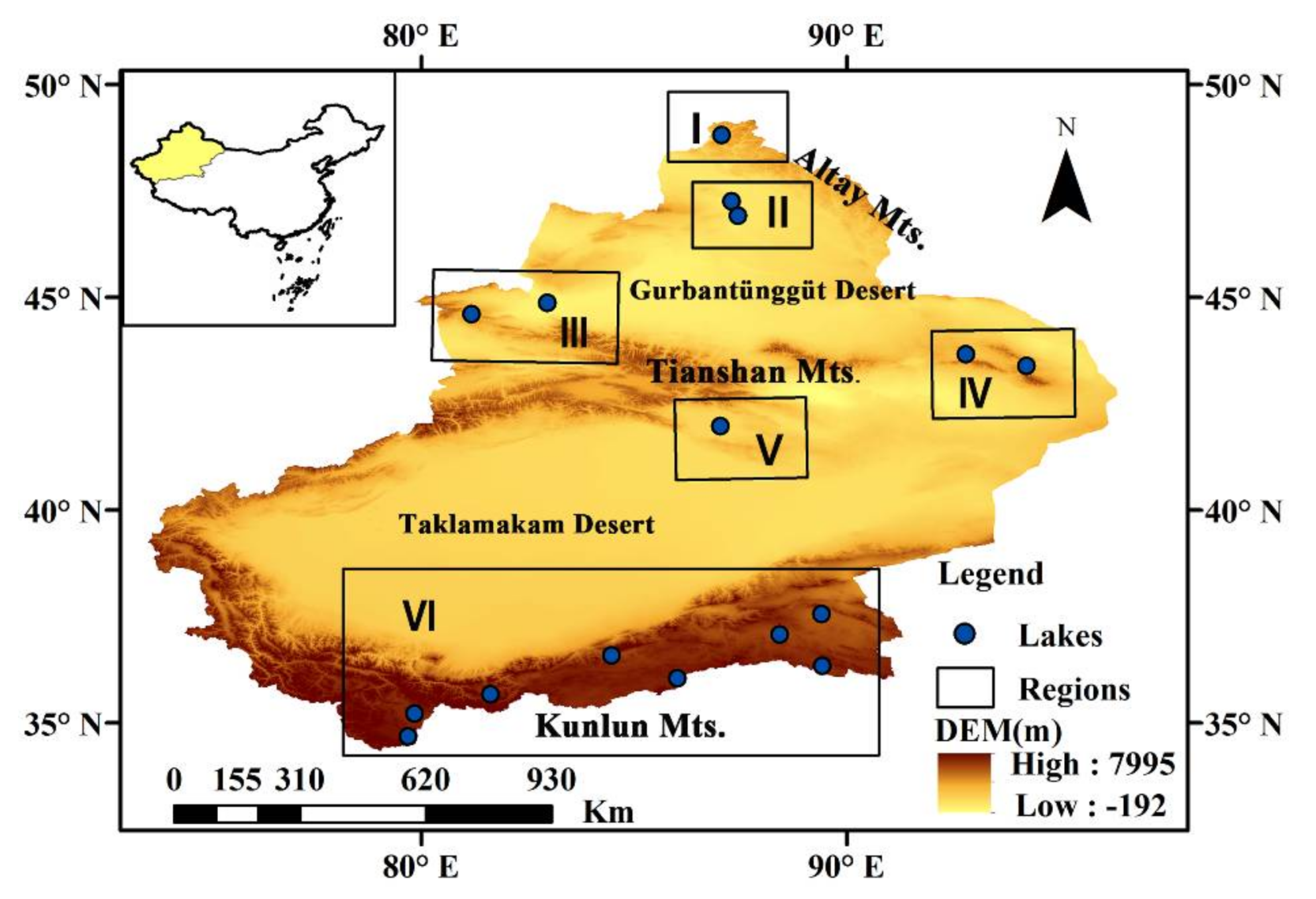
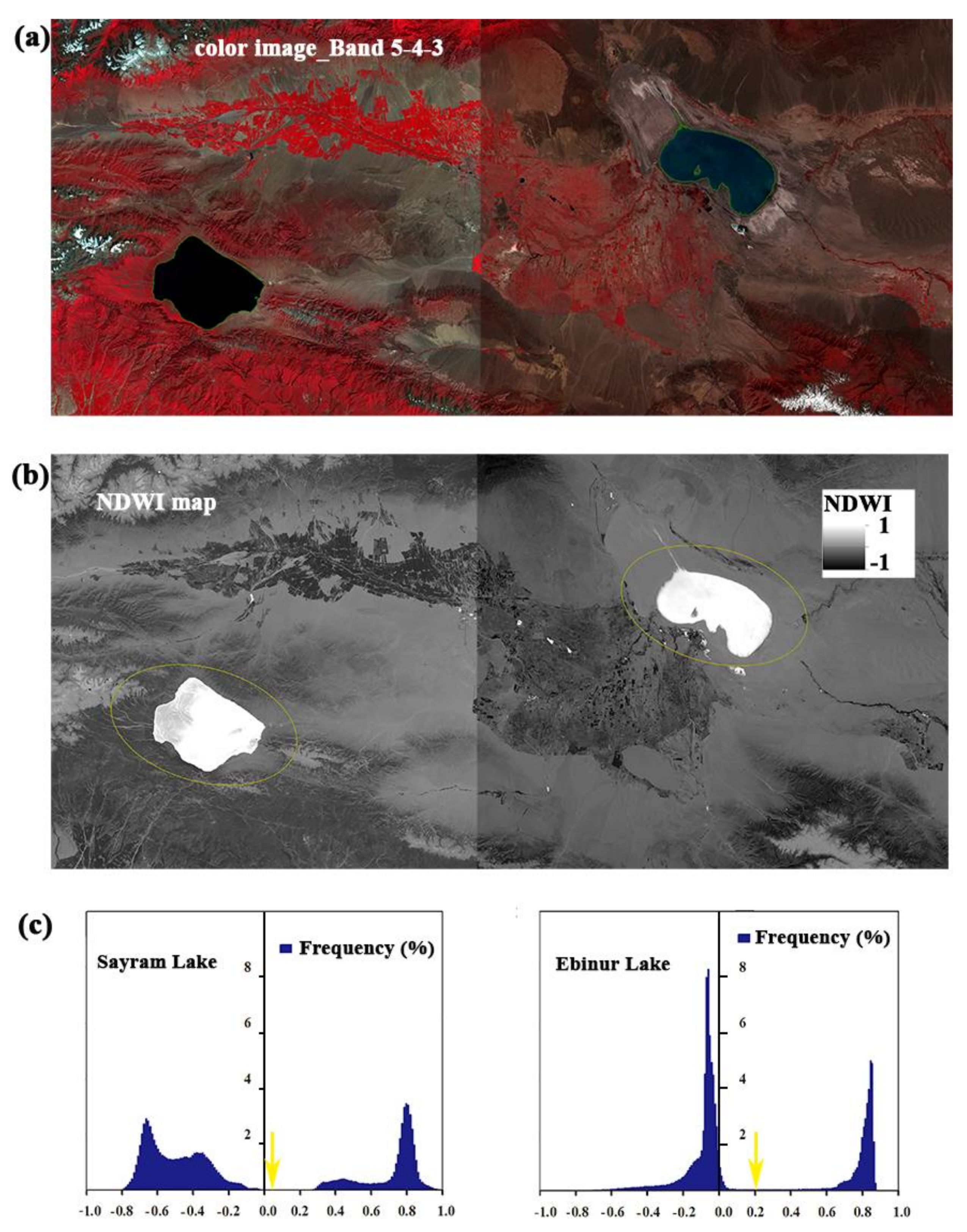
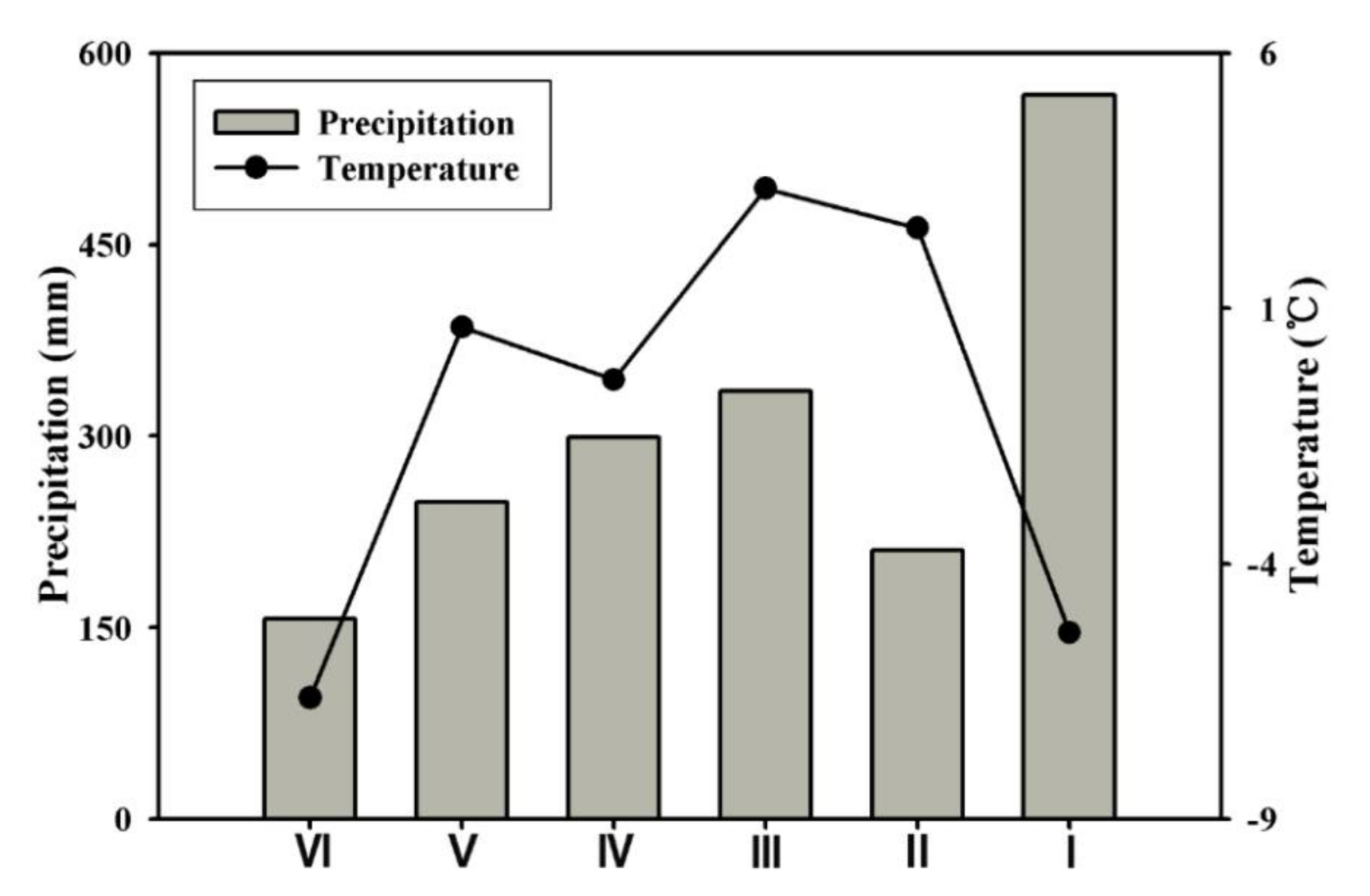
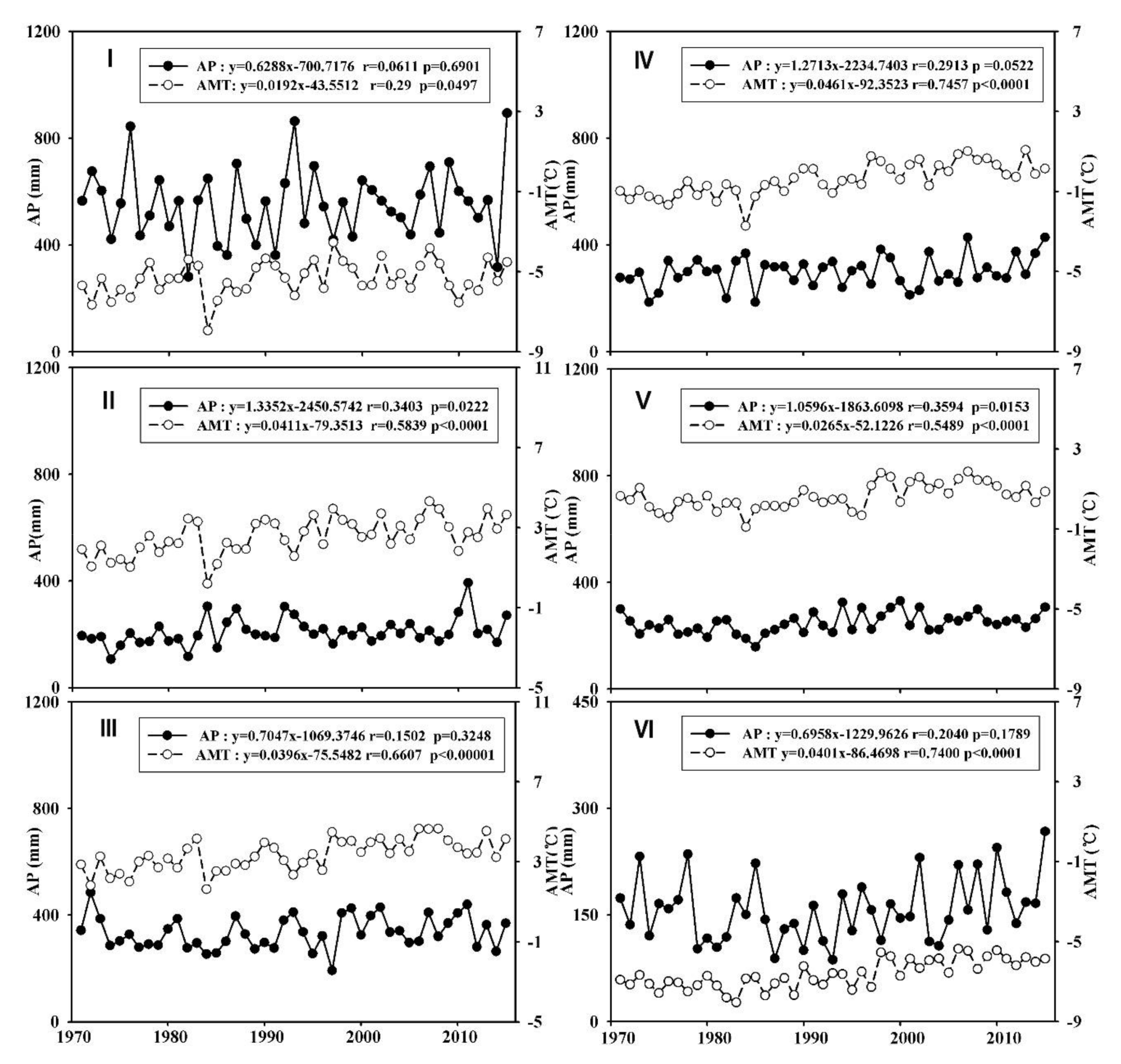
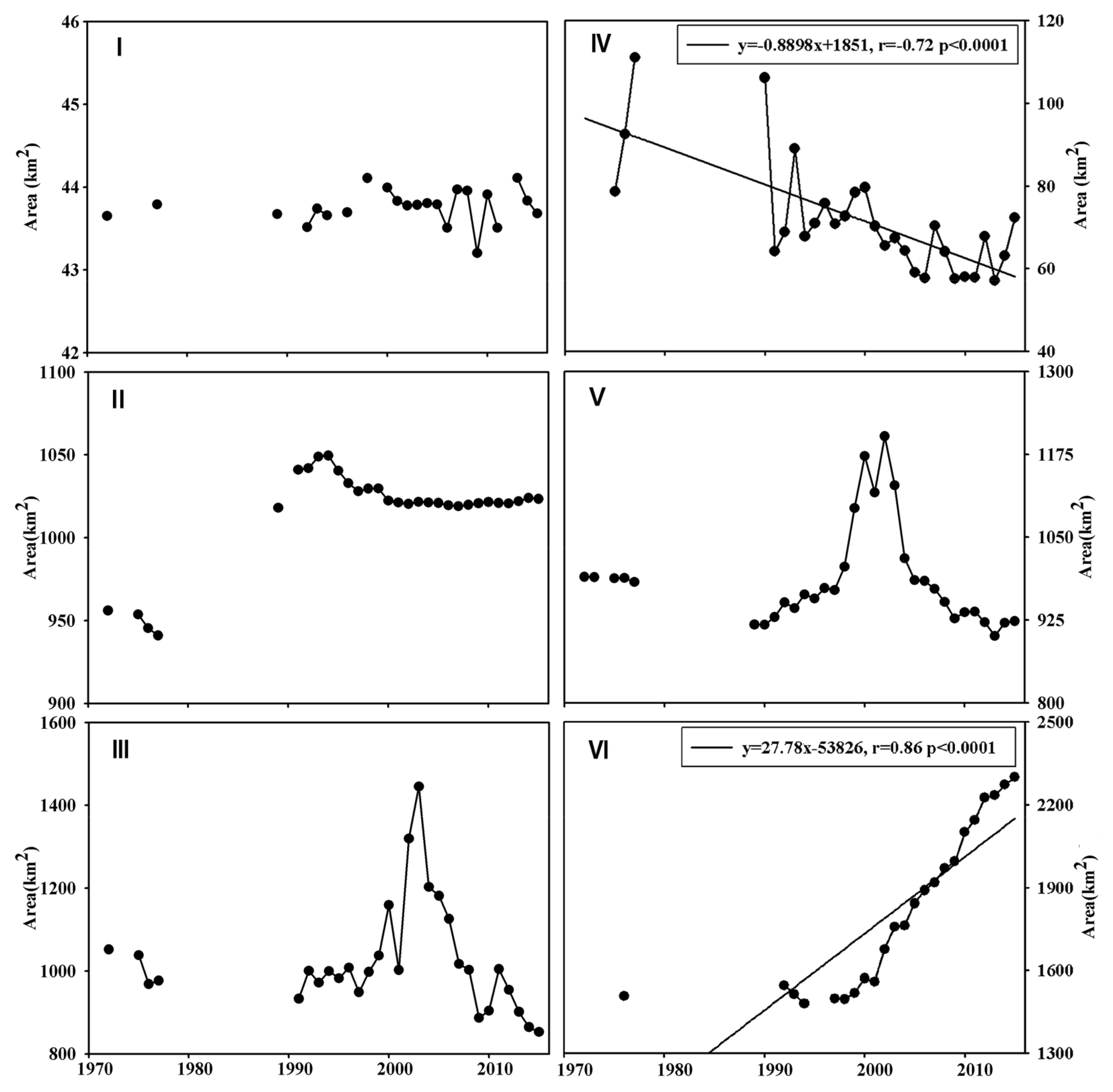
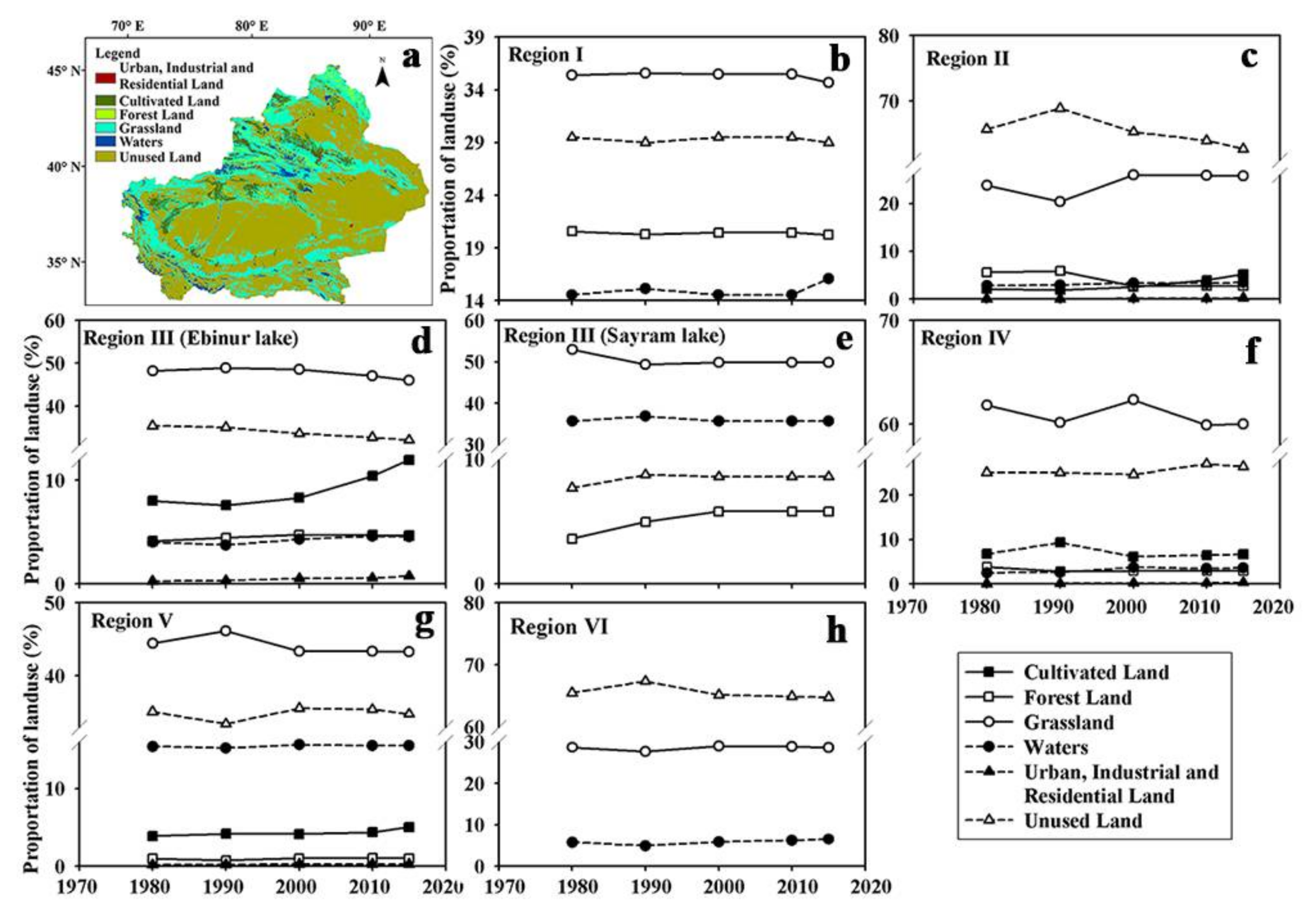
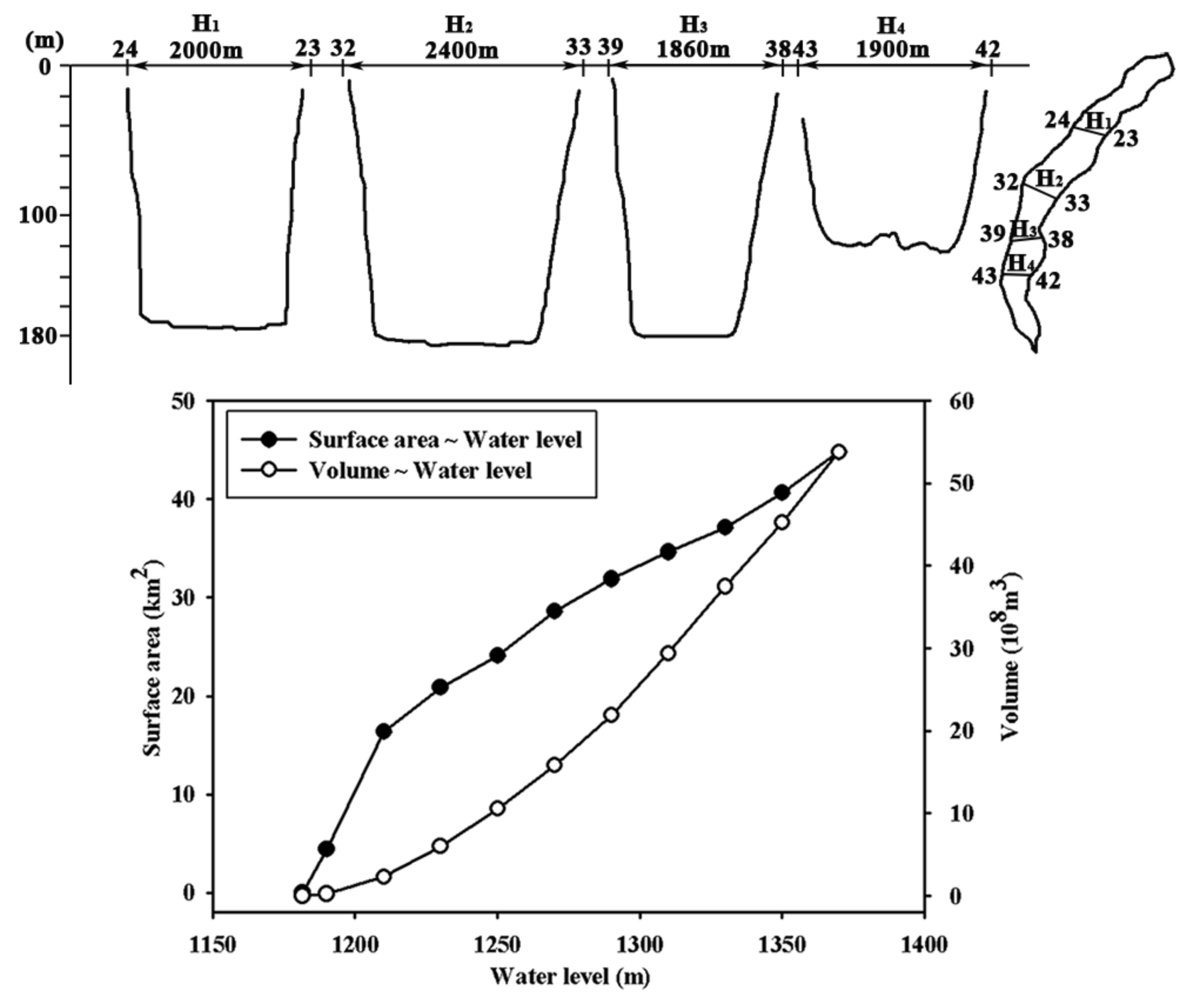
| Region | Lakes | Area in the 1970s (km2) | Change Rate (%) | Area in 2015 (km2) | |||
|---|---|---|---|---|---|---|---|
| 1970s–1993 | 1993–2004 | 2004–2015 | 1970s–2015 | ||||
| I | Kanas Lake | 43.72 | 0.04 | 0.15 | −0.29 | −0.09 | 43.68 |
| II | Ulungur Lake | 778.76 | 12.32 | −2.63 | 0.21 | 9.60 | 853.50 |
| Jili Lake | 162.57 | 7.18 | −2.66 | 0.17 | 4.51 | 169.90 | |
| III | Sayram Lake | 455.79 | 0.29 | 0.54 | 0.30 | 1.13 | 460.96 |
| Ebinur Lake | 554.01 | −7.44 | 44.66 | −47.14 | −29.22 | 392.12 | |
| IV | Barkol Lake, | 74.18 | −12.02 | −37.78 | 22.71 | −32.82 | 49.83 |
| Toale Culler | 21.39 | 10.94 | −0.13 | −4.99 | 5.26 | 22.51 | |
| V | Bosten Lake | 987.70 | −5.65 | 9.32 | −9.36 | −6.51 | 923.41 |
| VI | Saligil Kollakan | 47.34 | 4.36 | 38.18 | −8.78 | 31.54 | 62.27 |
| Aksai Chin Lake | 168.99 | −0.93 | 11.18 | 39.94 | 54.14 | 260.48 | |
| Urukkule Lake | 14.98 | 3.31 | 4.21 | 5.94 | 14.05 | 17.09 | |
| Tashkule Lake | 11.11 | −4.57 | 9.70 | 158.49 | 170.62 | 30.05 | |
| Changhong Lake | 17.77 | −19.09 | 112.48 | 81.86 | 212.64 | 55.56 | |
| Whale Lake | 276.53 | −7.01 | 12.01 | 17.40 | 22.28 | 338.16 | |
| Aqqikkol Lake | 359.66 | 0.65 | 16.31 | 27.97 | 49.81 | 538.81 | |
| Ayakekum Lake | 615.44 | 3.63 | 15.92 | 34.41 | 61.47 | 993.73 | |
| Region | AP | P1 | P2 | P3 | AMT | T3_5 | T6_8 |
|---|---|---|---|---|---|---|---|
| I | 0.26 | 0.03 | 0.26 | 0.24 | 0.18 | 0.14 | −0.02 |
| II | 0.38 * | −0.13 | 0.21 | 0.55 ** | −0.28 | −0.25 | −0.36 * |
| III (Sayram Lake) | −0.02 | 0.01 | −0.08 | −0.09 | 0.49 ** | 0.56 ** | 0.47 ** |
| III (Ebinur Lake) | 0.44 * | 0.31 | 0.29 | 0.13 | −0.02 | 0.01 | 0.16 |
| IV | 0.32 | 0.22 | 0.26 | 0.25 | −0.27 | −0.27 | −0.48 ** |
| V | 0.34 * | 0.39 * | 0.32 | 0.38 * | 0.45 * | −0.03 | 0.35 * |
| VI | 0.58 ** | 0.09 | 0.45 * | 0.44 * | 0.36 * | 0.40 * | 0.20 |
© 2018 by the authors. Licensee MDPI, Basel, Switzerland. This article is an open access article distributed under the terms and conditions of the Creative Commons Attribution (CC BY) license (http://creativecommons.org/licenses/by/4.0/).
Share and Cite
Liu, Y.; Yang, J.; Chen, Y.; Fang, G.; Li, W. The Temporal and Spatial Variations in Lake Surface Areas in Xinjiang, China. Water 2018, 10, 431. https://doi.org/10.3390/w10040431
Liu Y, Yang J, Chen Y, Fang G, Li W. The Temporal and Spatial Variations in Lake Surface Areas in Xinjiang, China. Water. 2018; 10(4):431. https://doi.org/10.3390/w10040431
Chicago/Turabian StyleLiu, Yuting, Jing Yang, Yaning Chen, Gonghuan Fang, and Weihong Li. 2018. "The Temporal and Spatial Variations in Lake Surface Areas in Xinjiang, China" Water 10, no. 4: 431. https://doi.org/10.3390/w10040431




